Welcome to our expert guide on choosing the perfect microphone for singing. As a singer, your microphone is an essential tool that can make or break your performance. Whether you’re a beginner or a professional, finding the right microphone can enhance your vocal performance and take your singing to the next level. In this guide, we will explore the different types of microphones available for singers and provide recommendations for the best options based on your singing needs and preferences.
From dynamic microphones to condenser microphones, wireless microphones to USB microphones, we will cover it all. We will also discuss factors to consider when choosing a microphone for singing, how to test microphones, and proper microphone setup and maintenance. By the end of this guide, you will be equipped with the knowledge to choose the perfect microphone for your singing needs.
Key Takeaways:
- A microphone is an essential tool for singers to enhance their vocal performance.
- There are different types of microphones available for singers, including dynamic, condenser, wireless, and USB microphones.
- Choosing the perfect microphone involves considering factors like frequency response, polar pattern, and sensitivity.
- Proper microphone setup and maintenance are crucial for optimal performance and longevity.
- By the end of this guide, you will be able to choose the perfect microphone for your singing needs.
Understanding Microphone Types for Singing
When it comes to choosing a microphone for singing, there are three primary types to consider: vocal microphones, condenser microphones, and dynamic microphones. Each type has its unique characteristics and advantages, so it’s essential to understand their differences before making a decision.
Vocal Microphones
Vocal microphones are handheld microphones that are specially designed for live performances and recording vocals. They are versatile and can handle a range of frequencies, making them an ideal choice for singers. Vocal microphones are also durable and can withstand the demands of live performances.
Some popular examples of vocal microphones include the Shure SM58 and the Sennheiser e945.
Condenser Microphones
Condenser microphones are more sensitive than dynamic microphones, making them a great choice for recording vocals in a studio environment. They use an electrically charged diaphragm to capture sound, resulting in a more detailed and accurate sound reproduction.
Some popular examples of condenser microphones include the Audio-Technica AT4053b and the Neumann TLM 103.
Dynamic Microphones
Dynamic microphones are excellent for live performances and recording vocals in noisy environments. They are less sensitive than condenser microphones but can handle high sound pressure levels without distortion. Dynamic microphones are also more affordable than condenser microphones.
Some popular examples of dynamic microphones include the Shure SM7B and the Electro-Voice RE20.
Now that you understand the different types of microphones available for singing, you can make a more informed decision when choosing the perfect microphone for your needs.

Top-Rated Microphones for Singing
Choosing the perfect microphone for singing can be overwhelming, but we’ve got you covered with our list of top-rated options. These microphones have been selected based on their exceptional sound quality, versatility, and value for money.
| Microphone | Type | Price | Rating |
|---|---|---|---|
| Shure SM58-LC | Dynamic | $99 | 4.8/5 |
| Audio-Technica AT4053B | Condenser | $599 | 4.7/5 |
| AKG Pro Audio C214 | Condenser | $369 | 4.6/5 |
| Rode NTK | Tube Condenser | $529 | 4.5/5 |
| Sennheiser e965 | Condenser | $699 | 4.4/5 |
These microphones range from budget-friendly to professional-grade, ensuring there’s an option for every singer. The Shure SM58-LC is a classic choice for live performances and offers excellent feedback rejection. The Audio-Technica AT4053B is ideal for recording vocals and provides exceptional audio clarity. The AKG Pro Audio C214 delivers warm and rich tones, making it perfect for studio recordings. The Rode NTK’s tube condenser design produces smooth and warm sounds for a vintage feel. Finally, the Sennheiser e965 is a top-of-the-line condenser microphone with a supercardioid polar pattern that minimizes background noise and enhances vocal clarity.
When searching for the best microphone for singing, it’s essential to consider your singing style, budget, and the type of performance you’ll be doing. But rest assured, any of these top-rated microphones will elevate your singing game and help you sound your best.

Professional-Grade Microphones for Singing
For the serious singer, investing in a professional-grade microphone can make a significant difference in their vocal performance. These microphones offer superior sound quality, durability, and features that make them stand out from entry-level options. Let’s explore some of the top professional microphones for singing:
| Microphone | Features | Price |
|---|---|---|
| Shure SM7B | Dynamic microphone with a smooth, warm sound that is perfect for vocals. It has switchable bass roll-off and mid-range boost, making it versatile for different vocal styles. It also has excellent background noise rejection, making it ideal for noisy environments. | $399 |
| Neumann U87 AI | Condenser microphone with a large-diaphragm that captures detailed and natural-sounding vocals. It has switchable polar patterns, allowing singers to adjust the microphone’s sensitivity to capture different types of vocals. It also has a -10 dB pad to handle high sound pressure levels. | $3,200 |
| Audio-Technica AT4053B | Hypercardioid condenser microphone with excellent off-axis rejection, perfect for live singing performances. It has a wide frequency response and high SPL handling, allowing singers to deliver powerful and nuanced performances. | $699 |
These are just a few examples of the top professional-grade microphones for singing. Depending on your budget and vocal style, there are many other options available. When choosing a professional microphone, it’s essential to consider factors like frequency response, polar pattern, and sensitivity to find the perfect match for your voice.

Wireless Microphones for Singing
If you are a singer who loves to move around on stage, a wireless microphone is the perfect solution for you. It offers you the freedom to roam around without worrying about tripping over cables or getting tangled up. With a wireless microphone, you can deliver a confident and energetic performance. Let’s dive into some of the best wireless microphones available for singing.
Shure GLXD24/SM58 Digital Wireless Microphone System
This is a premium wireless microphone system that offers exceptional sound quality and reliable performance. It has a durable build and a long battery life, enabling you to perform for extended periods without interruptions. The microphone features an SM58 dynamic capsule that delivers warm and clear vocal reproduction, making it ideal for live performances.

Audio-Technica System 10 ATW-1102
The Audio-Technica System 10 ATW-1102 is an easy-to-use wireless microphone system that delivers professional-grade sound quality. It has a compact and portable design, making it ideal for singers who frequently travel. The microphone offers a natural and detailed sound, allowing you to convey every nuance of your voice.
Sennheiser XSW 1-825 Dual-A Wireless Microphone System
This wireless microphone system is perfect for duets, bands, or larger performances, offering simultaneous dual-channel operation. The microphone has a cardioid polar pattern that reduces background noise and feedback, ensuring your vocals remain clear and focused. The Sennheiser XSW 1-825 is easy to set up and use, making it an excellent choice for both amateur and professional singers.
Pro Tip: When choosing a wireless microphone, make sure to check its frequency range and ensure it is compatible with other audio equipment you have. It is also essential to choose a microphone with a long battery life and a reliable wireless connection to avoid any technical glitches during performances.
USB Microphones for Singing
If you’re looking for a convenient and affordable way to record your singing, a USB microphone is an excellent choice. USB microphones offer plug-and-play convenience, allowing you to record directly into your computer without the need for additional equipment.
Benefits of USB Microphones
USB microphones are compact and easy to use, making them ideal for singers looking to record at home or on the go. They offer the following benefits:
- Easy setup and use
- No need for additional audio interfaces or mixers
- Compact and portable
- Affordable compared to other types of microphones
USB microphones are also available in various shapes and sizes, making them suitable for different recording situations.
Top USB Microphones for Singing
There are many USB microphones on the market, but not all of them are suitable for singing. We’ve curated a list of the top USB microphones for singers based on their sound quality, versatility, and value for money:
| Brand | Model | Price | Key Features |
|---|---|---|---|
| Blue | Yeti | $129.99 | Multiple polar patterns, headphone output, mute button, gain control |
| Rode | NT-USB Mini | $99.00 | Studio-quality sound, compact and portable design, pop shield, tripod stand |
| Samson | Meteor Mic | $69.99 | Large 25mm diaphragm, cardioid pickup pattern, headphone output, fold-back legs for optimal positioning |
All three of these USB microphones feature excellent sound quality and offer features that are perfect for singers. Additionally, they are affordable, making them accessible to singers on all budgets.

Conclusion
If you’re looking for a convenient and affordable way to record your singing at home, a USB microphone is an excellent choice. With the right USB microphone, you can capture studio-quality vocals with ease, allowing you to share your music with the world.
Microphones for Live Performances
If you are a singer performing live, you need a microphone that can withstand the demands of the stage. Live performance microphones should be rugged, durable, and capable of rejecting feedback. Here are some excellent options:
Vocal Microphones
Vocal microphones are a reliable choice for live performances, with many models specifically designed for singers. These microphones typically feature a cardioid polar pattern that isolates the singer’s voice and minimizes background noise. Some of the best vocal microphones for live performances include:
| Microphone | Price | Features |
|---|---|---|
| Shure SM58 | $99 | Durable construction, cardioid polar pattern, tailored for vocals |
| Electro-Voice RE20 | $449 | Large diaphragm, variable-D technology reduces proximity effect, internal pop filter |
| Sennheiser e965 | $699 | Switchable cardioid/super-cardioid polar pattern, low-cut filter, shock-mounted capsule |
Wireless Microphones
Wireless microphones provide freedom of movement on stage, making them perfect for energetic performers who like to move around. They typically use UHF or VHF frequencies to transmit the signal to a receiver. Some top-rated wireless microphones for live performances include:
| Microphone | Price | Features |
|---|---|---|
| Shure BLX288/PG58 | $549 | Dual-channel wireless, cardioid polar pattern, up to 14 hours of battery life |
| Audio-Technica System 10 ATW-1102 | $379 | Digital wireless, automatic frequency selection, 24-bit/48 kHz audio resolution |
| Sennheiser XSW 2-ME3-A | $499 | Wireless headset microphone, cardioid polar pattern, up to 10 hours of battery life |
No matter what type of microphone you choose for your live performances, remember to treat it with care. Avoid dropping or mishandling the microphone, and always use a protective case when transporting it to gigs. With proper care and maintenance, your microphone can last for years, delivering outstanding sound quality every time you perform.

Microphones for Recording Vocals
Recording vocals requires a microphone that can capture every nuance and detail of the singer’s voice. A high-quality microphone designed for recording vocals can make a significant difference in the final product. When choosing a microphone for recording vocals, there are several factors to consider.
Frequency Response
The frequency response of a microphone refers to the range of frequencies that the microphone can accurately capture. Vocals typically fall within the midrange of the frequency spectrum, so a microphone with a flat and even frequency response in this range is ideal for recording vocals.
Polar Pattern
The polar pattern of a microphone refers to the directionality in which it captures sound. For recording vocals, a cardioid polar pattern is commonly used as it captures sound from the front while rejecting sounds from the sides and rear. This helps reduce unwanted background noise and ensures that the vocals are captured with clarity.
Sensitivity
The sensitivity of a microphone refers to how much sound pressure it can pick up. For recording vocals, a microphone with high sensitivity is preferred as it can capture even the softest nuances of a singer’s voice. However, too much sensitivity can result in unwanted noise, so finding a balance is crucial.
Top Microphones for Recording Vocals
Some of the top microphones for recording vocals include:
| Microphone | Frequency Response | Polar Pattern | Sensitivity |
|---|---|---|---|
| Shure SM7B | 50Hz-20kHz | Cardioid | -59dBV/Pa |
| AKG Pro Audio C214 | 20Hz-20kHz | Cardioid | 20mV/Pa |
| Audio-Technica AT4053B | 20Hz-20kHz | Hypercardioid | -34dBV/Pa |
Each of these microphones offers exceptional sound quality and is highly regarded in the recording industry.
Whether you’re a professional singer or looking to record vocals at home, choosing the right microphone can make all the difference. Consider the factors mentioned above and explore different microphone options to find one that suits your needs.
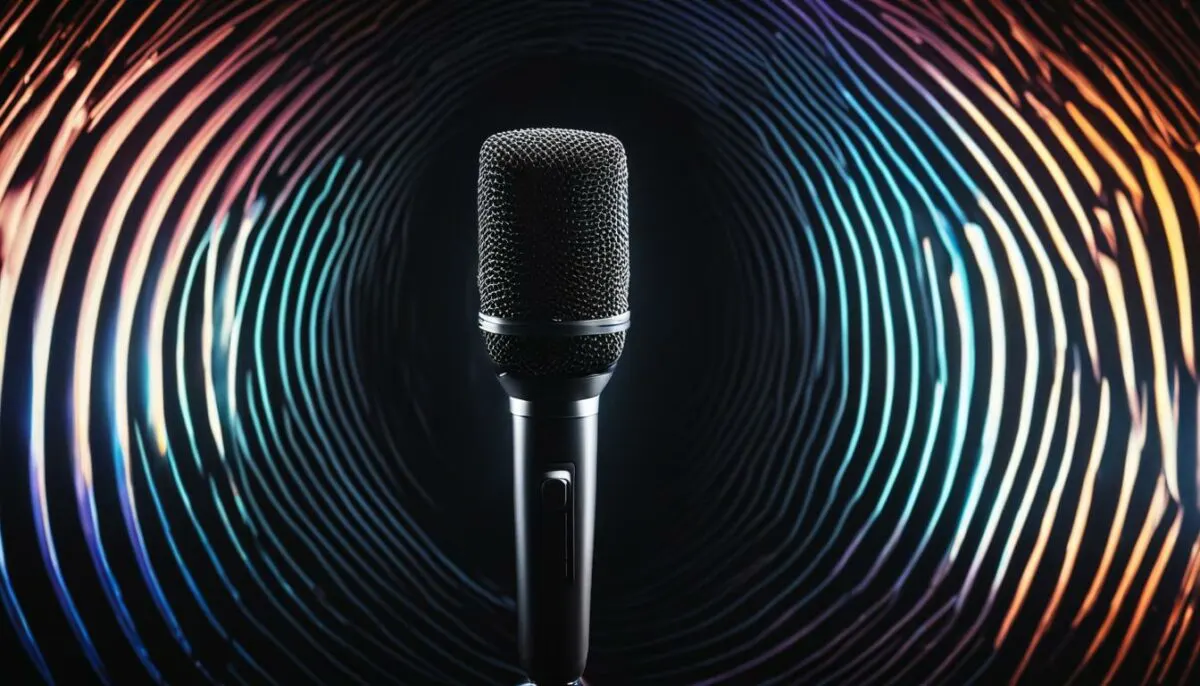
Factors to Consider When Choosing a Microphone for Singing
If you’re looking for a microphone for singing, there are several factors to consider to ensure you find the right option for your needs. Here are some crucial factors to keep in mind:
Polar Pattern
The polar pattern refers to the directionality of a microphone, affecting how it captures sound. The three most common polar patterns for singing are cardioid, supercardioid, and omnidirectional. Cardioid is the preferred choice for most singers, as it captures sound from the front while rejecting ambient noise from the sides and back. Supercardioid patterns provide even more directionality, ideal for singers who move around a lot on stage. Omnidirectional patterns capture sound from all directions, making them suitable for recording choirs or groups of singers.
Frequency Response
The frequency response of a microphone refers to how it captures different frequencies of sound. For singing, you want a microphone with a flat frequency response, meaning it captures all frequencies evenly without emphasizing any particular range. Some microphones are tailored specifically for certain vocal ranges like high or low frequencies, so consider your singing style when choosing a microphone.
Sensitivity
The sensitivity of a microphone refers to its ability to pick up quiet sounds, measured in decibels (dB). For singing, you want a microphone with a high sensitivity level, ensuring your vocals are clear and well-defined. However, high sensitivity levels can also increase the risk of feedback during live performances. Therefore, consider the environment you’ll be performing in when selecting a microphone based on sensitivity.
Condenser vs. Dynamic Microphones
Condenser and dynamic microphones are the two main types of microphones used for singing. Condenser microphones are more sensitive and provide a more detailed and accurate sound, making them ideal for studio recording. Dynamic microphones are more rugged and durable, making them suitable for live performances and touring. Consider your intended use when deciding between these two types of microphones.
Budget
The price of a microphone can range from a few hundred dollars to several thousand dollars. Generally, more expensive microphones offer better sound quality and durability. However, there are also excellent budget options available that provide great value for money. Consider your budget and what features are essential for your needs when choosing a microphone.
By taking into account these essential factors, you can make an informed decision when choosing a microphone for singing. Remember to consider your specific needs and preferences to find the perfect microphone that enhances your vocal performance.
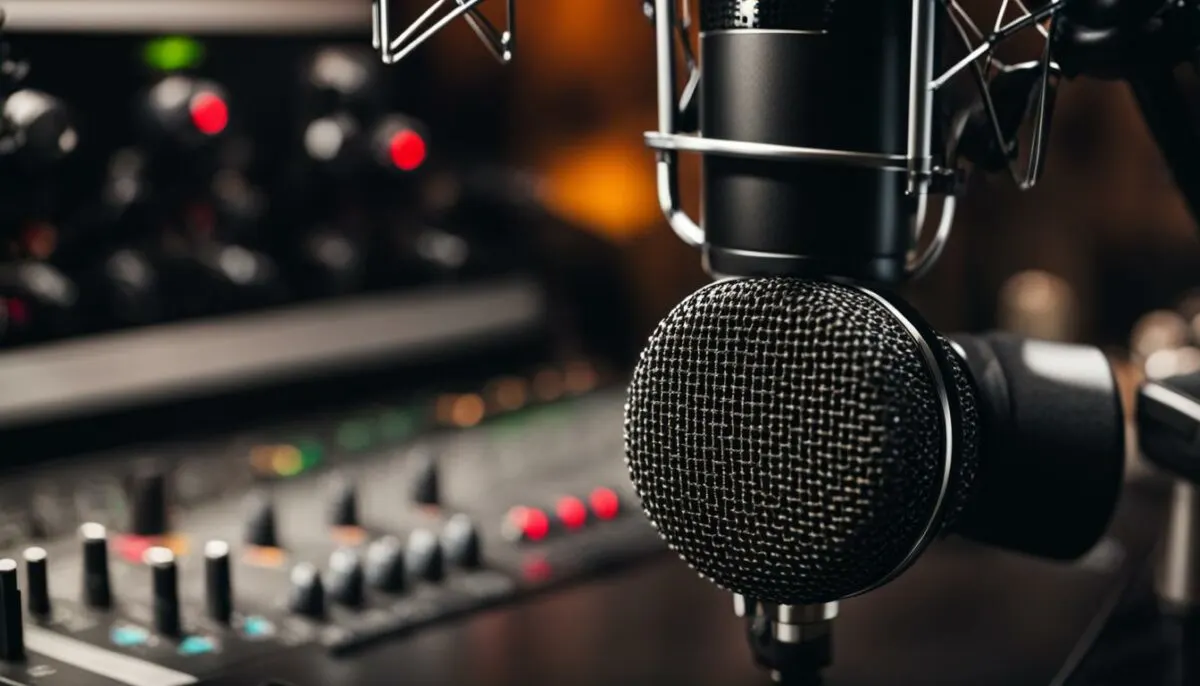
How to Test Microphones for Singing
Testing a microphone before purchase is essential to ensure you find one that complements your voice and style. Here are some tips on how to test microphones for singing:
- Know your singing style: Consider your vocal range, tone, and power to determine what type of microphone will suit your singing style. Dynamic microphones are ideal for singers with powerful, loud voices, while condenser microphones are perfect for capturing subtle nuances and details in softer vocals.
- Test in various environments: Try testing the microphone in different environments to assess its sound quality, frequency response, and feedback resistance. Sing in a quiet room, a large hall, and an open space to discern how the microphone performs in different settings.
- Consider microphone position: Experiment with microphone placement to determine how it affects the sound output. Try different angles, distances, and heights to find the optimal position for your singing style.
- Compare and contrast: If possible, test multiple microphones to compare and contrast their features. This allows you to identify the microphone that best suits your needs, and make an informed decision.
Whether you’re a beginner or a seasoned performer, testing microphones is an essential part of finding the perfect microphone for singing. By following these tips, you can make a confident purchase that will enhance your vocal performance and take your singing to the next level.

Microphone Accessories for Singing
Enhance your microphone setup with accessories that can improve sound quality, provide additional protection, or enhance your overall performance. Here are some popular microphone accessories for singers:
Microphone Stands
A sturdy microphone stand is essential for singers who want to keep their hands free while performing. There are different types of stands available, including tripod stands, boom stands, and desktop stands. Choose a stand that suits your performance needs and offers stability and adjustability.
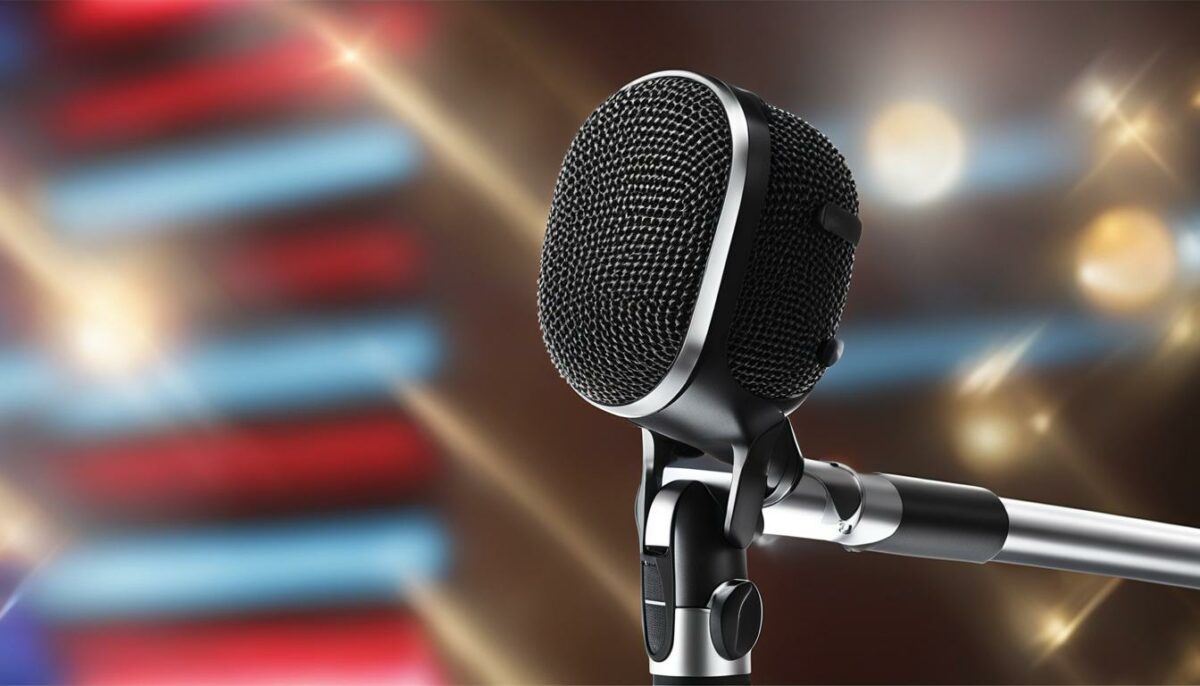
Pop Filters
Pop filters are placed in front of the microphone to reduce the popping sound that occurs when a singer pronounces words with hard consonants like “p,” “b,” or “t.” A pop filter can help eliminate unwanted noise and improve sound quality.
| Pros | Cons |
|---|---|
| Reduces popping sounds | May require occasional cleaning |
| Improves sound quality | Can attenuate high-frequency sounds |
| Easy to install |
Shock Mounts
A shock mount suspends the microphone within a frame, isolating it from vibrations and mechanical noise. This can help eliminate unwanted sounds like handling noise or low-frequency rumble, resulting in cleaner recordings or performances.
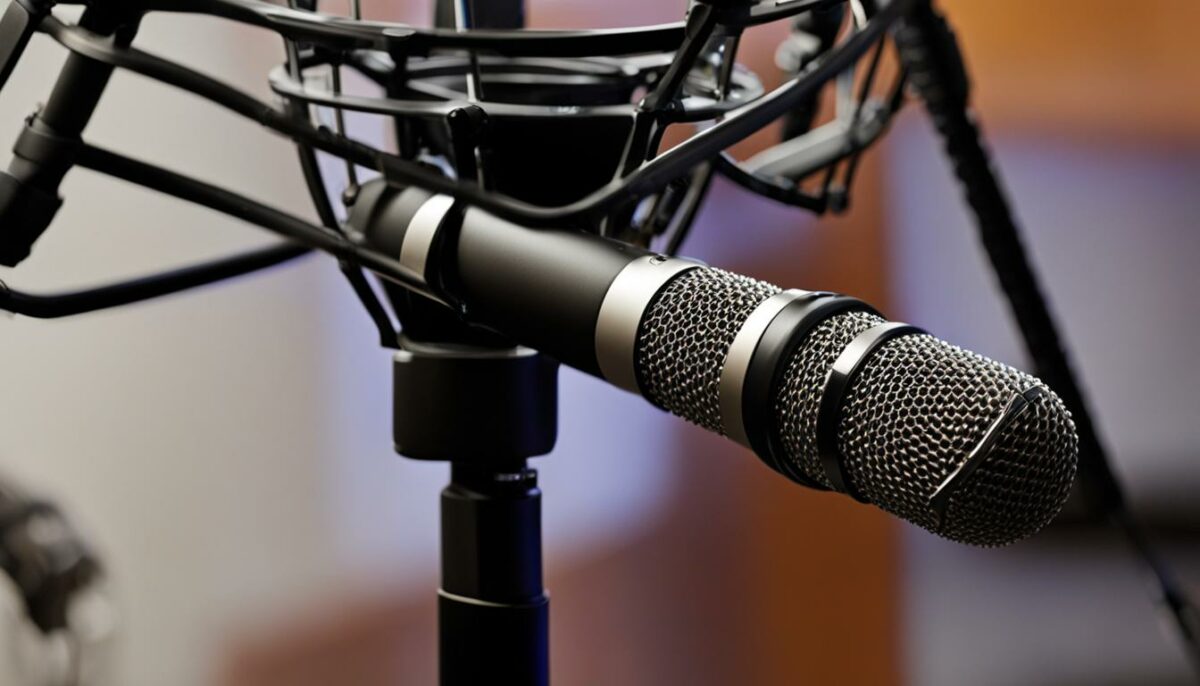
Wind Screens
Wind screens are placed in front of the microphone to reduce wind noise when singing outdoors or in windy environments. They can help prevent unwanted noise and improve the clarity of vocals.
- Effectively reduces wind noise
- Easy to install and remove
- Can come in different colors and patterns
Adding accessories to your microphone setup can be a cost-effective way to enhance your singing experience and improve sound quality. Choose accessories that best fit your needs and vocal style.
Setting Up Your Microphone for Singing
Proper microphone setup is essential for achieving optimal sound quality and ensuring your voice sounds its best. Follow these simple steps to set up your microphone for singing:
- Choose the right microphone for your needs: Consider factors like frequency response, polar pattern, and sensitivity to choose the ideal microphone for your singing style. Refer to previous sections of this guide for further information.
- Locate the sweet spot: Find the perfect position for your microphone by experimenting with different distances and angles. It’s best to position your microphone at mouth level and about a fist distance away to avoid popping sounds.
- Connect your microphone: Use the appropriate cables to connect your microphone to your sound system or recording device. Ensure that all connections are securely in place to avoid signal loss or interference.
- Use a pop filter: A pop filter helps prevent harsh consonant sounds like “p” or “t” from distorting your microphone. Attach the pop filter to the microphone stand or boom arm, placing it about an inch away from the microphone.
- Avoid feedback: Feedback is a common problem when using microphones. Ensure that your microphone is not picking up any sounds from your speakers or amplifiers by positioning it away from them. Additionally, reduce the volume of your speakers to prevent sound from being re-amplified and creating a feedback loop.
- Test your microphone: Before beginning your singing session or performance, test your microphone setup to ensure that everything is working correctly. Refer to the previous sections of this guide for testing tips.
By following these simple steps, you can ensure optimal microphone setup for singing. Remember to maintain proper microphone etiquette, and keep your microphone clean and well-maintained to prolong its lifespan and ensure consistent performance.

Maintaining and Cleaning Your Microphone
Regular maintenance and cleaning are essential to keep your microphone in top condition and ensure consistent performance, whether you use it for singing or other purposes. Follow these tips to maintain and clean your microphone:
- Store your microphone in a clean, dry place to prevent dust and moisture buildup.
- Use a soft-bristled brush or microfiber cloth to remove dust and debris from the microphone surface.
- For tougher grime, use a damp cloth or cotton swab to gently clean the microphone surface.
- Avoid excessive moisture and harsh chemicals when cleaning your microphone, as they can damage the microphone’s delicate components.
- Regularly check the microphone cable for any signs of wear or damage and replace it if necessary.
- Check your microphone’s specifications and follow the manufacturer’s instructions for recommended cleaning and maintenance practices.
By following these maintenance and cleaning tips, you can prolong the lifespan of your microphone and ensure consistent performance for years to come.
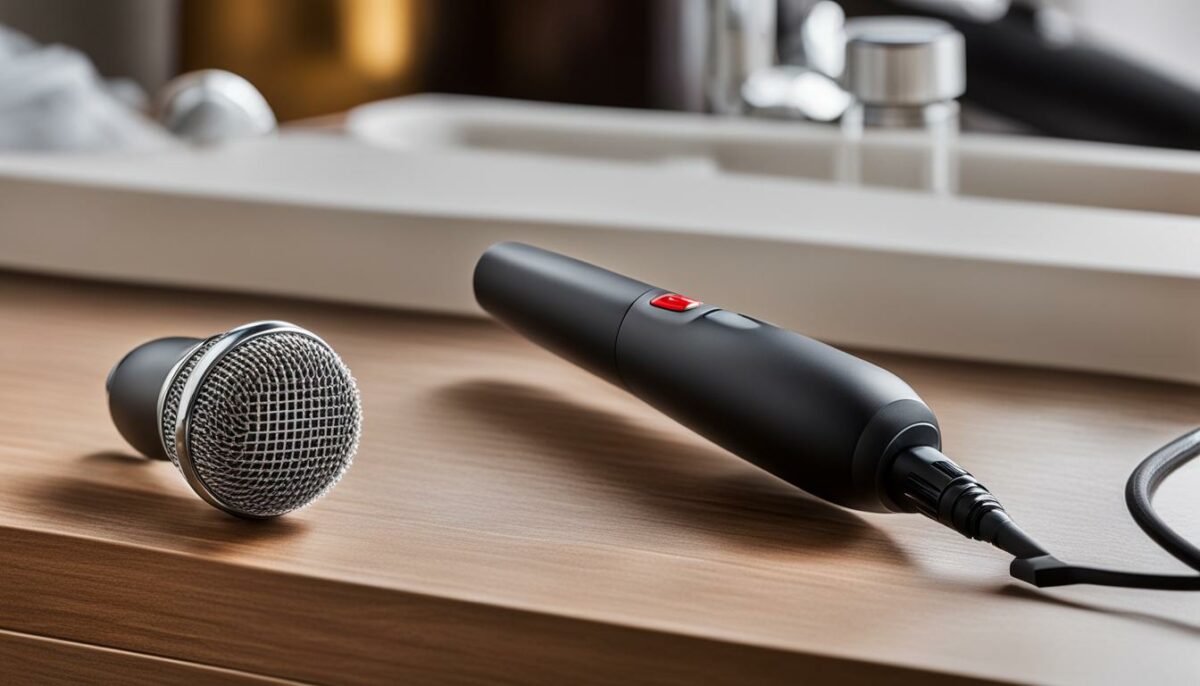
Microphone Etiquette for Singing
Using a microphone correctly can make a significant difference in how your singing sounds to the audience. Whether you are performing in a small venue or a large concert hall, follow these microphone etiquette tips:
- Hold the microphone correctly: When singing, hold the microphone about an inch away from your mouth. Avoid holding the microphone too close or too far as it can affect the sound quality.
- Don’t tap or blow into the microphone: Tapping or blowing into the microphone can cause unwanted noise and damage the equipment.
- Maintain a consistent distance: Keep the microphone at a consistent distance throughout your performance. This will ensure that your sound remains consistent and balanced.
- Avoid popping sounds: Use a pop filter if you tend to make popping sounds while singing. This can help reduce the popping sound and ensure a smoother performance.
- Avoid feedback: Feedback can occur when the microphone and speakers interact with each other, causing a high-pitched sound. To avoid this, keep the microphone away from the speakers or turn down the volume.
Tips for Using a Microphone During Live Performances
When using a microphone during live performances, consider the following:
- Test the microphone before your performance: Test the microphone and sound equipment before your performance to ensure that everything is working correctly.
- Communicate with the sound engineer: Communicate with the sound engineer about your microphone needs, including the volume, EQ, and any effects.
- Be aware of microphone placement: Be aware of the microphone’s placement and adjust your position accordingly to ensure your vocals are captured clearly.
- Hold the microphone steady: Hold the microphone steady and avoid swinging it around as it can cause unwanted noise and affect the sound quality.
- Maintain appropriate microphone technique: Maintain appropriate microphone technique, such as holding the microphone at a consistent distance and avoiding tapping or blowing into the microphone.
By following these microphone etiquette tips, you can ensure that you achieve optimal sound quality during your singing performances.

Troubleshooting Common Microphone Issues
Using a microphone for singing can enhance your performance, but sometimes, technical issues arise that can disrupt your sound quality. Here are some common problems and solutions to help you troubleshoot:
Feedback
Feedback occurs when sound from the speakers is picked up by the microphone and amplified, creating a loud, high-pitched screeching noise. To avoid feedback, try the following:
- Move the microphone away from the speakers or any other noise sources.
- Reduce the volume of the speakers.
- Point the microphone away from the speakers.
- Use a feedback suppressor or equalizer.
If you’re using a wireless microphone, check for interference from other wireless devices or sources of electromagnetic interference like cell phones or Wi-Fi routers.
Distortion
Distortion happens when the sound level is too high, causing the microphone to overload and produce a distorted sound. To avoid distortion, try the following:
- Reduce the volume of the sound source or the microphone.
- Move the microphone further away from the sound source.
- Use a pop filter to reduce plosives and other unwanted sounds.
- Check the microphone placement and ensure it’s not too close to your mouth or other sound sources.
Connectivity Issues
If you’re experiencing connectivity issues, check the following:
- Make sure the microphone is properly connected to the device and the cables are not damaged.
- Check the audio settings on your device and make sure the microphone is selected as the input device.
- Ensure the microphone’s batteries are fully charged or replace them if needed.
- If you’re using a wireless microphone, check the signal strength and move closer to the receiver.
If you’re still experiencing issues, consult the microphone manufacturer’s troubleshooting guide or reach out to their support team for assistance.

Conclusion
Congratulations on making it through our expert guide to choosing the perfect microphone for singing! We hope you found this article helpful in selecting the ideal microphone to match your singing style and needs.
Remember, understanding the different types of microphones available is essential before deciding which to purchase. Whether you’re looking for a wireless microphone for live performances, a USB microphone for recording, or a professional-grade microphone for enhanced sound quality, there’s a microphone out there for everyone.
Don’t forget to test your microphone before making a final decision. Knowing how to set up your microphone correctly, as well as maintain and clean it, will ensure it lasts for years to come. Get creative with microphone accessories and follow microphone etiquette guidelines to maximize your performance potential!
We hope you found this guide helpful in finding the best microphone for singing. Remember, your microphone is a vital tool in enhancing your vocal performance, so take the time to choose the right one. Happy singing!
FAQ
How do I choose the perfect microphone for singing?
To choose the perfect microphone for singing, consider factors like frequency response, polar pattern, and sensitivity. It’s important to prioritize features based on your singing style and preferences.
What are the different types of microphones available for singing?
There are three main types of microphones for singing: vocal microphones, condenser microphones, and dynamic microphones. Each type has its own characteristics and benefits.
What are the best microphones for singing?
We have curated a list of the best microphones for singing based on performance, sound quality, and value for money. In our top-rated microphones section, we review each microphone and highlight their unique features to help you make a choice.
Are there professional-grade microphones for singing?
Yes, professional-grade microphones offer superior sound reproduction and durability. We explore high-end options favored by professional singers in our professional-grade microphones section.
Are there wireless microphones for singing?
Yes, wireless microphones provide freedom of movement for singers who perform on stage or in larger venues without compromising sound quality. We present wireless microphone options perfect for singers who want to break free from cables.
Can I use USB microphones for singing?
USB microphones are a convenient choice for singers who want to record their vocals directly into a computer or laptop. We discuss the benefits of USB microphones and recommend excellent options for home recording or online streaming.
Are there microphones specifically designed for live performances?
Yes, microphones designed for live singing have features like rugged construction and feedback rejection to withstand the demands of a live performance environment. We explore these microphones in the microphones for live performances section.
What microphones are best for recording vocals?
To capture studio-quality vocals, it’s essential to choose a microphone optimized for recording. We discuss microphones that excel in capturing the nuances and details of a singer’s voice in our microphones for recording vocals section.
What factors should I consider when choosing a microphone for singing?
When choosing a microphone for singing, consider factors like frequency response, polar pattern, and sensitivity. We explain these factors in detail and provide insights on what to prioritize based on your singing style and preferences.
How do I test microphones for singing?
Before making a final decision, it’s crucial to test the microphones you are considering. We share tips and techniques for testing microphones to ensure you find the one that suits your voice and performance needs.
What are some microphone accessories for singing?
Enhance your microphone setup with accessories that can improve sound quality, provide additional protection, or enhance your overall performance. We discuss popular accessories like microphone stands, pop filters, and shock mounts.
How do I set up my microphone for singing?
Proper microphone setup is crucial to achieving optimal sound quality. We provide step-by-step instructions on how to position and connect your microphone, ensuring you get the best results during your singing sessions or performances.
How do I maintain and clean my microphone?
Regular maintenance and cleaning are essential to prolonging the lifespan of your microphone and ensuring consistent performance. We share tips on how to take care of your microphone to keep it in pristine condition.
What is the microphone etiquette for singing?
Using a microphone properly is crucial, especially when performing in live settings. We provide etiquette guidelines and helpful tips to ensure you maximize the microphone’s potential while respecting your audience and fellow performers.
What should I do if I encounter microphone issues?
Sometimes, you may encounter issues with your microphone. We troubleshoot common problems like feedback, distortion, and connectivity issues, offering practical solutions to help you overcome these challenges.